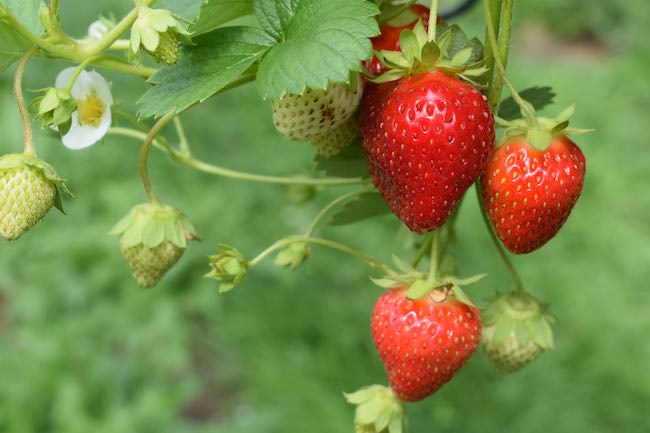
Strawberries require a sunny position in your garden. Ideally, they need to be grown in the ground however if you do not have a space in your garden or have a courtyard garden strawberries are suitable to grow in pots.
To grow strawberries in the UK, you will need to follow these steps:
- Choose a sunny spot with well-drained soil to plant your strawberries.
- Purchase healthy, disease-free strawberry plants from a reputable nursery.
- Prepare the soil by digging in organic matter such as compost and adding a general fertilizer.
- Plant your strawberries in the early spring, making sure to space them about 30cm apart.
- Water your strawberries regularly, especially during dry spells.
- Apply a mulch layer around the plants to conserve moisture and suppress weeds.
- Provide support for the plants by tying them to stakes or installing a trellis.
- Pinch off the first flowers to encourage the plants to produce more runners, which will form the basis for your new plants.
- Harvest your strawberries when they are fully ripe and pick off any damaged or diseased fruit promptly to prevent the spread of disease.
- Keep your strawberry patch weed-free and maintain the soil moisture levels to keep your plants healthy and productive.
Growing strawberries in pots
Growing strawberries in pots is a great option for those with limited space. Here are the steps to grow strawberries in pots:
- Choose a pot with adequate drainage holes and fill it with a well-draining soil mix, such as a mixture of potting soil, compost, and sand.
- Purchase healthy, disease-free strawberry plants from a reputable nursery.
- Place your strawberry plants in the pot, making sure they are spaced adequately and have enough room to spread out.
- Water your strawberries regularly, making sure the soil stays moist but not waterlogged.
- Provide support for the plants by tying them to stakes or installing a trellis, especially if you are growing them in a large pot.
- Place the pot in a sunny spot, ideally with at least 6 hours of direct sunlight per day.
- Pinch off the first flowers to encourage the plants to produce more runners, which will form the basis for your new plants.
- Harvest your strawberries when they are fully ripe and pick off any damaged or diseased fruit promptly to prevent the spread of disease.
- Fertilize your strawberries regularly with a balanced, water-soluble fertilizer to keep the plants healthy and productive.
- Replenish the soil in the pot every 2-3 years and repot the plants into a slightly larger pot as they grow to ensure they have enough room to spread out.
Main pest problems with strawberries
There are several pests that can cause problems for strawberry plants. Some of the most common include:
- Slugs and snails: These pests feed on the leaves and fruit of strawberries, leaving holes in the foliage and damaging the fruit.
- Spiders mites: These tiny, red pests feed on the underside of strawberry leaves, causing yellowing and a stippled appearance.
- Aphids: Aphids feed on the sap of strawberry plants and can weaken the plants, reduce growth, and spread diseases.
- Cutworms: These pests chew through the stems of young strawberry plants, causing them to wilt and die.
- Strawberry crown borers: These pests feed on the crowns of strawberry plants, causing stunted growth and reduced yields.
- Strawberry root weevils: These pests feed on the roots of strawberry plants, causing reduced growth and weakened plants.
To control these pests, use a combination of cultural practices, such as removing plant debris, mulching, and rotating crops, as well as using physical controls, such as hand-picking, using row covers, and using appropriate pesticides if needed. It’s also important to identify the pests accurately and select the right control method to avoid causing harm to beneficial insects or the environment.






















